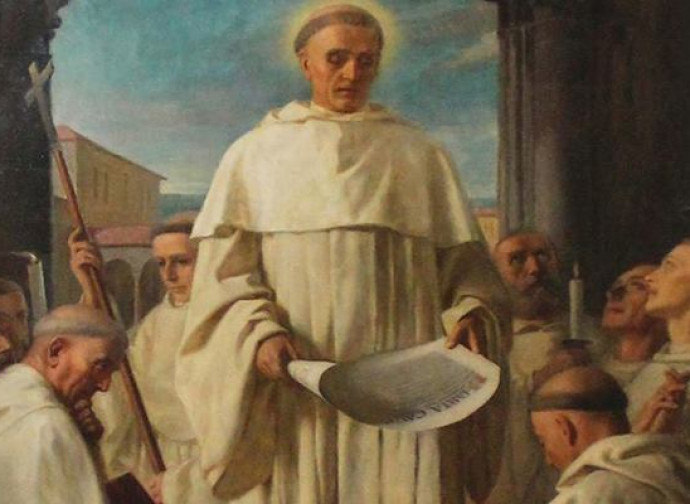Saint Stephen Harding
He was one of the co-founders of the Cistercian Order, became the third abbot of Citeaux and wrote the famous Charta Caritatis.

A painting that synthesises how the Cistercian Order was born depicts Saint Stephen Harding (c. 1060-1134) in the company of Saint Robert of Molesme and Saint Alberic of Citeaux, with the Madonna and Child in the centre. Before Providence brought the three founders of the Cistercians together, the Englishman Stephen, born in the county of Dorset, had had an eventful youth. After professing his monastic vows in the Benedictine abbey of Sherborne, he had abandoned religious life during the turbulent period following the Norman conquest of England. He moved first to Scotland and then to Paris, where he delved deeper into his studies. Regretting having left monastic life, he went on a pilgrimage to Rome to obtain forgiveness, accompanied by a young cleric with whom he recited the entire Psalter along the way.
On the way back from that pilgrimage, Stephen and his friend stopped in Burgundy, at the abbey of Molesme, founded in 1075 by Saint Robert (c. 1029-1111). The latter hoped to reach a balance between the Cluniac and eremitic Benedictine models, in the name of greater austerity and a revival of manual labour. Robert's reforming ideas aroused the enthusiasm of Stephen and 20 other monks, all eager for a closer observance of the original Rule of Saint Benedict. On 21 March 1098, after obtaining the necessary authorizations, Robert and his monks founded the Abbey of Citeaux in a marshy location then called Cistercium: thus the Cistercian Order was born.
The beginnings for the Cistercians were not easy. Robert was only able to stay in charge of the new monastery until July 1099, because the monks who remained in Molesme appealed to Urban II for the return of the founder of their abbey. In the meantime, things were not going well there. Out of obedience, Saint Robert returned to Molesme, while at Citeaux his successor as abbot was Saint Alberic († 1108/09), who led the Cistercians through their hardest years. The new order was in danger of dying out because of the difficulty in attracting new vocations. At this stage Stephen Harding was the prior and in 1108 became the third abbot of Citeaux. In his quarter of a century at the head of the abbey (he became ill and resigned one year before his death), the English saint devoted himself to the re-writing of liturgical books to adhere more faithfully to the Benedictine spirit. He also worked on a scrupulous revision of the Vulgate.
In 1112 an event of capital importance for the future of the order took place: Stephen welcomed into the monastery a young man of great faith and personality, Saint Bernard of Clairvaux (c. 1090-1153), who wore the Cistercian habit and arrived with about thirty companions. Thanks to the providential arrival of the new monks, Stephen was soon able to direct his religious to found the “primary abbeys”, as the first four abbeys directly descended from the mother house of Citeaux are called: La Ferté (1113), Pontigny (1114), Morimond (1115) and Clairvaux (1115), the latter founded by Bernard himself. In order to guarantee the unity of the order, now rapidly expanding and marked by a fervent Marian devotion, Stephen wrote the famous Charta Caritatis. This document regulated the relations between the mother house and all the other daughter-abbeys, establishing that every year the abbot of Citeaux should visit the various monasteries and convene a General Chapter, so as to preserve the charism and watch over the observance of the discipline. A wise model of internal government, which the IV Lateran Council (1215) would ask the other religious orders to adopt.


